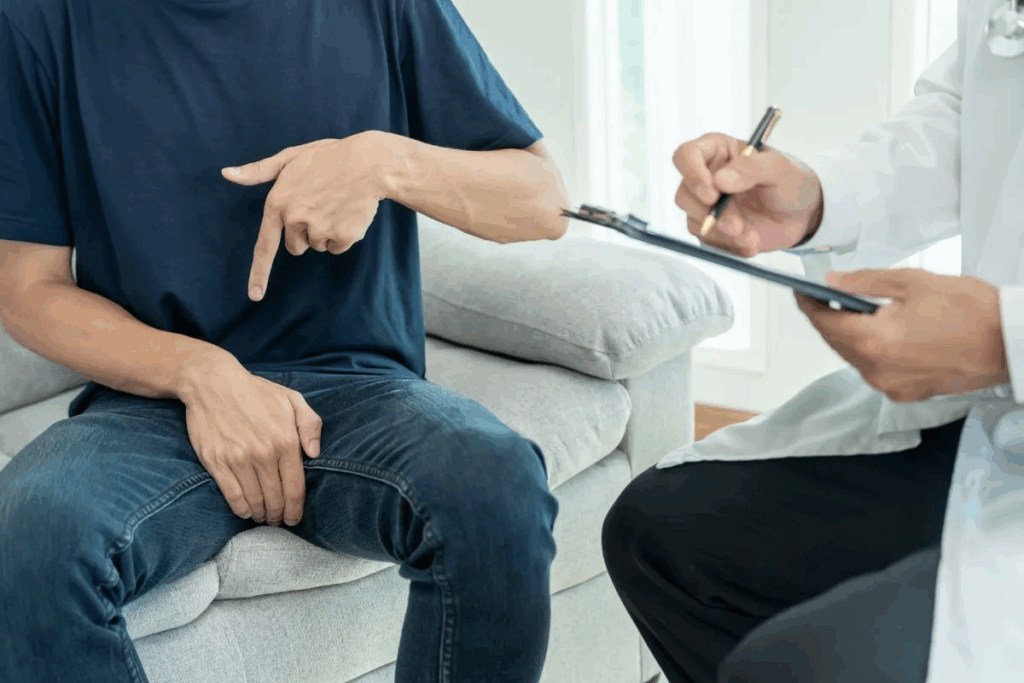Last Updated on November 27, 2025 by Bilal Hasdemir

Urinary incontinence is a big problem for many men after prostate cancer treatment, and it greatly affects their quality of life. Up to 90% of men face some incontinence after prostate removal as part of their prostate surgery recovery. This can be tough and upsetting, often requiring the use of adult diapers like Depends for bladder control. Understanding that urinary incontinence is common and managing it effectively is important for improving life after surgery.
Knowing how long you might need Depends can help plan and deal with this issue. The good news is that many men see their incontinence get better over time. This article will give you insights into how bladder control recovers and how long you might wear adult diapers after treatment.

Many men face urinary incontinence after prostate surgery. This condition affects their daily life and well-being. It’s not just about leaking urine; it’s a serious issue.
Urinary incontinence happens because the surgery damages the muscles around the prostate. The prostate gland is surrounded by nerves and muscles that control urination. Surgery in this area can cause incontinence, sometimes lasting a long time.
Men may face two main types of urinary incontinence after surgery: stress incontinence and urge incontinence. Stress incontinence happens when physical activity causes urine leakage. Urge incontinence is when a sudden urge to urinate leads to involuntary loss of urine.
| Type of Incontinence | Description | Common Triggers |
| Stress Incontinence | Involuntary leakage of urine during physical activity | Coughing, sneezing, lifting heavy objects |
| Urge Incontinence | Sudden, intense need to urinate followed by involuntary urine loss | Running water, cold temperatures, certain foods or drinks |
Knowing the type of incontinence is key to finding the right treatment. Some men may have both stress and urge incontinence. Others may have symptoms that are more complex.

Knowing what to expect after prostate surgery can ease worries. The recovery has three main parts: right after surgery, a short period, and a long-term phase.
In the first two weeks, many patients face a lot of urinary incontinence. This is because the surgery affects the muscles and nerves around the bladder. It’s key to follow your doctor’s advice on handling incontinence during this time. Doctors often suggest using absorbent products to manage leaks.
As healing starts, most people see bladder control getting better. Doing pelvic floor exercises, like Kegels, can really help. These exercises make the muscles around the bladder stronger, leading to less leakage. During this time, the number of incontinence episodes usually goes down.
In the long run, most men see their bladder control keep getting better. Sticking to pelvic floor exercises and bladder training is key to recovery. Some men might get fully continent in a few months, but others might take a year or more.
By knowing the recovery timeline and doing rehabilitation exercises, patients can better their chances of regaining bladder control after prostate surgery.
It’s important to know what affects how long incontinence lasts after prostate surgery. The time it takes for a patient to stop leaking can change a lot. This depends on several key things.
A patient’s age and overall health greatly affect their recovery from prostate surgery. Older patients or those with health problems might take longer to stop leaking.
Older men often find it harder to control their bladder. This is because their muscles are weaker and their urinary sphincter might not work as well.
The surgical technique used also plays a big role. Methods that keep more tissue and nerves intact usually mean less time with incontinence.
Patients with pre-existing urinary issues before surgery might leak for longer. Problems like an overactive bladder or weak pelvic floor muscles can make recovery harder.
It’s key for patients to talk to their doctor about their risks. This way, they can know what to expect during recovery.
Many prostate surgeries have different effects on incontinence. This affects how well patients recover and their quality of life. Each surgery for prostate cancer has its own impact on bladder control.
Radical prostatectomy removes the prostate gland and some nearby tissue. It’s a common treatment for prostate cancer. But, it can greatly affect bladder control because of its close location to the bladder and urethra.
Impact on Incontinence: This surgery is linked to a higher risk of incontinence. How severe and long-lasting incontinence is can vary a lot among patients.
This surgery is a minimally invasive method that uses a robotic system for better precision. It’s known for quicker recovery times and less damage to nearby tissues.
Benefits for Continence: The precision of this surgery might help preserve the urinary sphincter and nerves better. This could lower the risk of incontinence.
TURP removes prostate tissue through the urethra. It’s mainly used for benign prostatic hyperplasia (BPH) instead of prostate cancer.
Incontinence Risk: TURP has a lower risk of causing lasting incontinence compared to radical prostatectomy. But, temporary urinary problems can happen.
| Surgical Procedure | Incontinence Risk | Recovery Time |
| Radical Prostatectomy | Higher | Several Months |
| Robotic-Assisted Laparoscopic Prostatectomy | Moderate to Low | Faster than Open Surgery |
| Transurethral Resection of the Prostate (TURP) | Lower | Generally Shorter |
Knowing the differences between these surgeries helps patients and doctors make better choices. It also helps manage what to expect about incontinence after surgery.
After prostate surgery, managing bladder control can be tough. Using the right incontinence products is key. It’s important to know the different types and their benefits.
There are many incontinence products out there. Depends is a well-known brand with various options. Other brands offer similar products, like adult diapers and pads, for comfort and privacy.
“The right incontinence product can greatly improve a patient’s life”.
Choosing the right absorbency level is critical. Products range from light to maximum absorbency. It’s important to think about your needs and maybe talk to a healthcare provider to find the best one.
For the best comfort and privacy, follow these tips:
Understanding the different incontinence products and picking the right one can help manage urinary incontinence after prostate surgery. Comfort and privacy are important for feeling confident and improving your life.
Pelvic floor exercises, like Kegel exercises, are key for bladder control after prostate surgery. They strengthen the muscles that support the bladder and help control urination. This can greatly improve bladder control and lower incontinence rates.
To do Kegel exercises right, you need to know which muscles to use. These are the muscles that stop urine flow. Here’s how to start:
Avoid squeezing your abdomen or buttocks. This can strain your body.
For best results, do Kegel exercises often. Aim to:
Even a few minutes a day can help a lot over time.
Keeping track of your progress can keep you motivated. You can:
By doing pelvic floor exercises and tracking your progress, you can improve your bladder control after prostate surgery.
Bladder training is key after prostate surgery. It helps men control their urine better. By using certain methods, they can manage their bladder and cut down on leaks.
Scheduled voiding means going to the bathroom at set times, not just when you need to. This helps your bladder hold more urine and lessens leaks.
Controlling how much you drink is also important. It helps ease the pressure on your bladder.
A bladder diary is a great tool for tracking your progress. It helps you see patterns in your urine habits. This diary can guide you in making changes.
Using these bladder training methods and keeping a diary can greatly improve bladder control after prostate surgery. It can also make life better overall.
Making lifestyle changes can greatly help with bladder control and recovery after prostate surgery. Healthy habits can improve your life during the recovery time.
Eating well is key for recovery after prostate surgery. Some foods can boost bladder control and health.
| Food | Benefit |
| Cranberries | May help prevent UTIs |
| Oatmeal | High in fiber, aids digestion |
| Water | Essential for hydration |
Light exercise can help with recovery and bladder control. It’s important to start slowly with your workouts.
Constipation is common after prostate surgery. It’s important to manage it well for comfort and recovery.
By making these lifestyle changes, you can greatly improve your recovery and bladder control after prostate surgery.
After prostate surgery, some men may need medical help to control their bladder. There are treatments for those who can’t stop leaking urine. These options can help manage and possibly fix the problem.
Some medicines can help with urinary incontinence. They work by treating issues like an overactive bladder or weak pelvic muscles. Here are a few examples:
For some, less invasive procedures can help with incontinence. These methods usually have shorter recovery times than traditional surgery.
Some examples are:
If other treatments don’t work, surgery might be an option. These surgeries can offer lasting solutions for incontinence.
Some surgical choices include:
Men with ongoing incontinence after prostate surgery should talk to their doctor. They can find the best treatment for their situation.
Incontinence after prostate surgery can deeply affect a person’s mental health. It can cause feelings of embarrassment, low self-esteem, and worry about the future.
It’s important to find ways to cope with the emotional and psychological effects of incontinence after prostate surgery. This can include:
Joining support groups can help you feel connected and understood. These groups are a place to share experiences and learn from others facing similar challenges.
| Resource | Description | Benefits |
| Support Groups | Community-based groups for sharing experiences | Emotional support, sense of community |
| Online Forums | Online platforms for discussion and advice | Accessibility, anonymity, diverse perspectives |
| Counseling Services | Professional counseling for emotional support | Personalized guidance, coping strategies |
Talking openly with partners and family is key. It helps build a support network and can make relationships stronger during tough times.
“Communicating openly with my family was key to my recovery. It helped me feel supported and understood.” – A prostate surgery patient.
By focusing on the emotional and psychological aspects of incontinence after prostate surgery, patients can improve their recovery. It’s about balancing physical symptom management with mental health.
Ongoing incontinence after prostate surgery can be worrying. It’s important to know when to see your doctor. While some incontinence is normal, some signs mean you need medical help.
If you notice any of these symptoms, you should talk to your doctor:
Table: Possible Complications and Their Symptoms
| Complication | Symptoms |
| Urinary Tract Infection (UTI) | Burning sensation while urinating, frequent urination |
| Bladder Issues | Difficulty starting or stopping urine flow, persistent leakage |
As
“The key to managing incontinence after prostate surgery lies in understanding the underlying causes and addressing them appropriately.”
This quote shows why seeing a doctor is key to managing incontinence after surgery.
At follow-up appointments, ask important questions. This helps you understand your recovery better. Consider asking:
Knowing the warning signs and asking the right questions helps. You can take steps to regain bladder control and improve your life after prostate surgery.
Real-life stories of recovery after prostate surgery give us valuable insights. They offer encouragement, guidance, and a clear view of what to expect during recovery.
Many case studies show how different patients recover after prostate surgery. For example, a 60-year-old man who had robotic-assisted surgery got his bladder control back in three months. On the other hand, a 70-year-old man who had a radical prostatectomy took about six months.
These stories remind us that recovery depends on many factors. Age, health, and the surgery type all play a role. They also stress the importance of tailored care and support during recovery.
Patient experiences teach us important lessons about managing post-prostatectomy incontinence. Pelvic floor exercises, like Kegels, are key to regaining bladder control. Also, a healthy lifestyle, including a balanced diet and exercise, helps a lot during recovery.
Patients who managed their fluid intake and practiced scheduled voiding did better. These strategies, along with medical support, can greatly improve your recovery.
Managing urinary incontinence is key for men after prostate surgery. Knowing the causes and types helps a lot. It also opens up many treatment options to improve after prostate surgery bladder control and life quality.
Age, surgery method, and past urinary problems can affect how long incontinence lasts. Adding pelvic floor exercises, bladder training, and lifestyle changes can help. This way, people can get better faster and manage prostate cancer bladder control better.
Knowing about medical help for ongoing incontinence is important. This includes medicines, small procedures, and surgery. By actively managing incontinence following prostate removal, men can take back control of their bladder. This improves their overall health and well-being.
Urinary incontinence after prostate surgery is when you can’t control your bladder. This means you might leak urine without meaning to. It happens because surgery can damage the muscles and nerves around the prostate.
How long it takes to get bladder control back varies. Most men leak urine right after surgery. But, this usually gets better in a few months to a year.
There are two main types after prostate surgery. Stress incontinence happens when you leak urine with physical activity. Urge incontinence is when you suddenly need to urinate very badly.
Kegel exercises strengthen the pelvic floor muscles. These muscles help control your bladder. Doing Kegels regularly can improve bladder control and lower incontinence risk.
Good incontinence products include adult diapers like Depends. Other options are pads and liners. The right product depends on how much you leak, what you prefer, and your lifestyle.
Yes, changing your diet, staying active, and managing constipation can help. Eating well, exercising, and keeping a healthy weight can improve bladder control.
For ongoing incontinence, there are medicines, minimally invasive procedures, and surgery. These can help control your bladder better and reduce leakage.
To cope, talk to healthcare professionals, support groups, and loved ones. Being open with your partner and family can help with stress and anxiety about incontinence.
See your doctor if you have ongoing or severe leakage, pain, or discomfort. They can check your condition and suggest treatments.
Yes, bladder training can help. Techniques like scheduled voiding, managing fluids, and keeping a bladder diary can improve control. They can help you manage your bladder better and reduce incontinence risk.
The type of surgery can change the risk of incontinence. For example, some surgeries might have higher risks than others. This includes radical prostatectomy and robotic-assisted laparoscopic prostatectomy compared to transurethral resection of the prostate (TURP).
Yes, age and health can influence how long incontinence lasts. Older men or those with health issues might experience longer incontinence periods.
Subscribe to our e-newsletter to stay informed about the latest innovations in the world of health and exclusive offers!